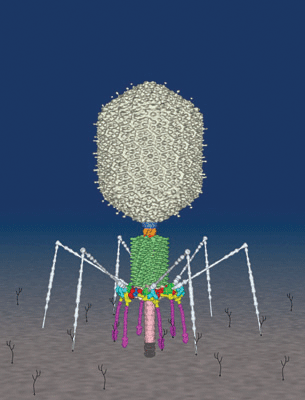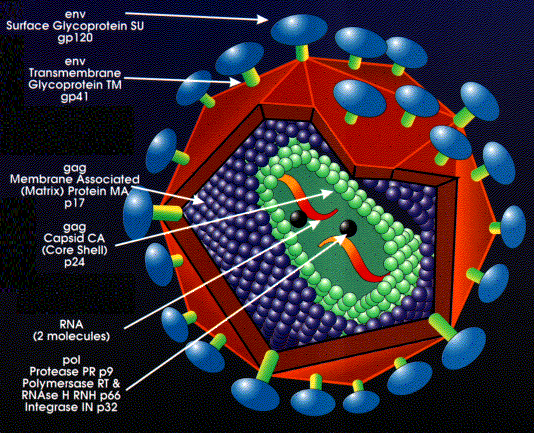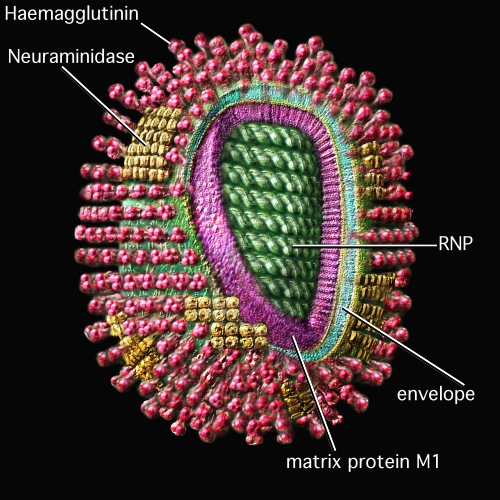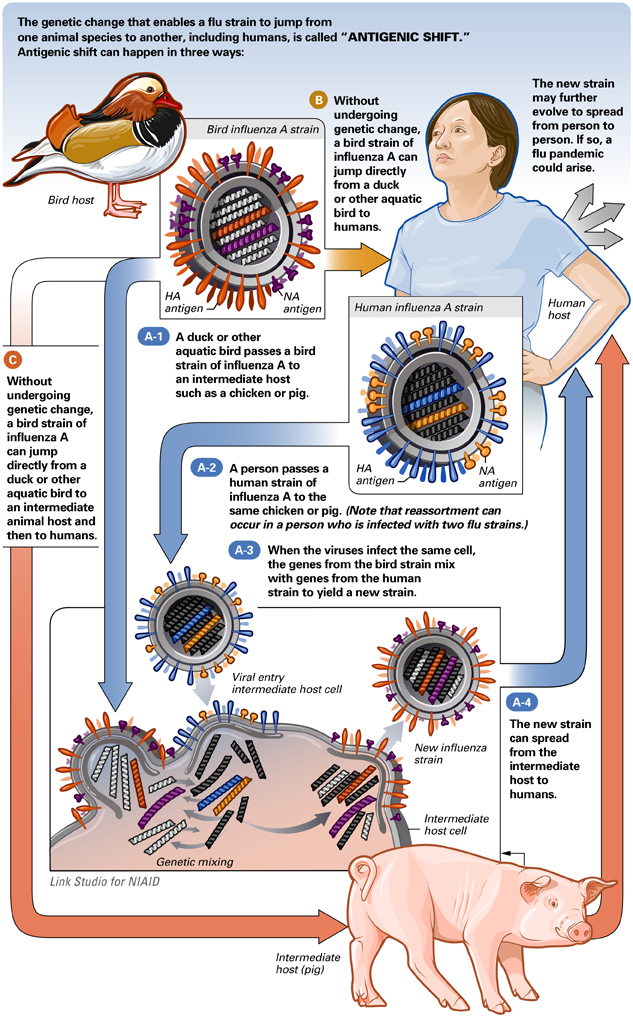|
|
| |
|
 Bacteriophage
Bacteriophage
|
| |
|
|
| |
The universe started 13.5 billion years ago with the "Big Bang". Our earth is approximately 4.5 billion years old. As the interstellar dust coalesced to form Earth, it took approximately another billion years for the planet to cool and for the water vapor in the atmosphere to condense and form the oceans.. It was during this time that bacteriophage and bacteria evolved. They existed in this primordial earth alone for over a billion years before the evolution of eucaryotic cells. Bacteria and bacteriophage are the "true senior citizens" of our planet. Today, bacteriophage are ubiquitous and are the most diverse and widely distributed entities in the biosphere. One of the denses sources of phage is in sea water, where it is reported that there can be as many as one billion virions per millimeter of water. Bacteriophage give us a unique window into the past where we can imagine an even earlier period of primordial abiotic molecular self-assembly. Bacteriophage |
|
|
|
|

The Classic Bacteriophage Structure
(Note the glycoproteins on the surface of the membrane.)
|
| |
|
|
|
| |
This virus type uses a eukaryotic cell as the host. The human immunodeficiency virus and the influenza A virus are examples of viruses that use a eukaryotic host.. |
|
|
|
|
|
|
|
 HIV Virus
HIV Virus |
| |
|
|

Flu Virus (H1N1 Virus)
Hemagglutinin and Neuraminidase are proteins that
project off the surface of a flu virus.
These proteins play a role in the
life cycle of the
virus. The function of these proteins is
to
let
the
virus
enter (hemagglutinin)
and exit (neraminidase) the host (our cells).
|
| |
|
| |
Antigenic Shift

National Institute of Allergy and Infectious Diseases /
Illustrator: Links Studio
|
| |
|
|
| |
Antigenic Shift |
|
| |
|
|
| |
| |
The genetic change that enables a flu strain to jump from one animal species to another, including humans, is called antigenic shift. Antigenic shift can happen in three ways:
Antigenic Shift 1
- A duck or other aquatic bird passes a bird strain of influenza A to an intermediate host such as a chicken or pig.
- A person passes a human strain of influenza A to the same chicken or pig.
- When the viruses infect the same cell, the genes from the bird strain mix with genes from the human strain to yield a new strain.
- The new strain can spread from the intermediate host to humans.
Antigenic Shift 2
- Without undergoing genetic change, a bird strain of influenza A can jump directly from a duck or other aquatic bird to humans.
Antigenic Shift 3
- Without undergoing genetic change, a bird strain of influenza A can jump directly from a duck or other aquatic bird to an intermediate animal host and then to humans.
The new strain may further evolve to spread from person to person. If so, a flu pandemic could arise. |
|
|
| |
|
|
|
| |
|
|
| |
Antigenic Drift |
|
| |
|
|
|
| |
|
|
| |
Antigenic Drift |
|
| |
|
|
| |
Influenza virus antigenic drift is a continual, gradual change in influenza A and B virus antigens. In the translation process (mRNA translated by ribosome inside the host's cytoplasm to make the new virus surface protein) errors occur in the amino acid sequence. |
|
| |
|
|
| |
-
Small changes are the result of point mutations in HA and NA that causes minor changes in the surface proteins.
-
As more point mutations occur with successive generations, a distinctly new surface protein results that produces a new strain. Antibodies to previous infections now may not recognize the altered surface protein which results from the point mutations.
-
This is the rational for global surveillance to select strains for annual vaccines.
|
|
| |
|
|
|
|
|
|
| |
| |
H1N1 2009 Flu Virus |
|
| |
|
|
| |
This image was taken recently by the CDC (4/28/09). On the outer margins of the virus you can see the hemagglutin and neuraminidase proteins. The diameter of these virions is approximately 100 nm.
(Note: The diameter of a ribosome is approximately 30 nm.) |
|
|
| |
|
| |
Reference Articles |
|
| |
| |
The Flu Virus
Structure of the influenza A virus and the role played by surface proteins. |
| |
|
| |
|
| |
|
| |
|
| |
|
| |
|
| |
|
| |
Phage Therapy
A Cold War Relic From the USSR Now Offer Advantages Over Antibiotics |
| |
|
| |
|
| |
|
| |
Games Parasites Play
Discussion about the evolutionary role created by the interactions between host and its parasites,
both bacteria and virus. The article explains how parasites evade cell-mediated immunity to avoid
destruction by the host's immune system
. |
| |
|
| |
The "Flu"
Discussion of the three types of influenza, the difference between antigenic shift and antigenic
drift,
and how flu vaccines are designed with historical reference data for the three components
of the vaccine
(H1N1 / H3N2 / Type B). |
| |
|
| |
Viruses
General review with discussion about evading immunity and the life cycle
of the virus, lysogeny vs lytic. |
| |
|
| |
Influenza A Virus Subtype H1N1
Historical perspective with discussion about the Spanish Flu of 1918, the more recent Russian Flu
of 1977, and the current Mexican Flu. The article explains how viruses which infect domesticated
animals (pigs, chickens, horses) can infect a common host (pig) to create a new virus that is capable
of infecting humans. |
| |
|
| |
|
| |
|
| |
The Plague
Plague is a bacterial disease caused by the enterobacteria Yersinia pestis. Throughout history,
mankind has been decimated by this pathogen. The Black Death of 1347 killed up to 50% of the
population in Europe and Asia. Discussion about how pathogens can change history
and transform civilization |
| |
|
| |
Avian Infulenza
Reference table of avian infuenza virus subtypes (31 HA / NA designation
combinations
with the avian influena A viruse type "common names").
Discussion about the most troubling subtype H5N1, the leading candidate as the
major threat to a pandemic with the potential to kill billions worldwide. |
|